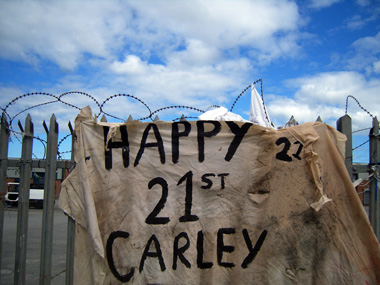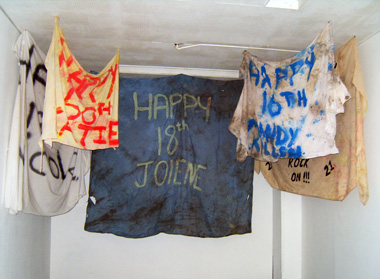Public address: the people’s wall is an exhibition documenting and recording an urban/ rural ritual prevalent in the County Down area of Northern Ireland. This body of work began in 2006 and is still ongoing, in keeping with the reproductive nature of the project. The ritual: birthday greetings publicly displayed on hand-written fabric banners or posters are habitually seen on the same bridges, same post boxes and same fences and so on…a family celebration is openly declared. This form of celebration can serve as a means of humiliation, as childhood mugshots are incorporated to advertise the age and generation of the victim. In this exhibition at PS2, the artists deliberately chose to showcase this project in a Belfast gallery in the hope of impregnating the spore of this ritual into another urban environment. Indeed, I first experienced Public address: the people’s wall in the Limerick City Gallery of Art as part of the ev+a 2008,Too early for vacation exhibition selected by international curator Hou Hanru. Moreover, the work garnered the Belltable Arts Award, affording the artists another exhibition in 2009.
 |
| Angela Darby and Robert Peters: Public address: the people’s wall, installation shot, PS2 Project Place, Belfast, September 2008; courtesy the artists |
The work showcased at the PS2 Gallery has grown and fluctuated into a more substantial installation. Relics found at one site, The Westwinds in Newtownards, hung from the ceiling as evidence of the cyclical nature of this ritual. At this one site the artists unearthed one fabric banner after another, buried and rotting at the roadside, resembling a ‘find’ from an archaeological dig. These fabric banners bore the scars of their discarded past, with soil and vegetation still clinging to their surfaces and lending the gallery a very earthy aroma. They were draped flag-like, remnants from a great battle – perhaps the greatest battle, that of finding meaning in our short existence. These works, personal acts, sit outside the standard commercialisation of social celebration. The objects have value without a high-street price, for the creators’ time is not money. As a disclaimer, the artists stated that they would never remove banners unless they had been detached through time or abandoned from their original place, instead preferring to document them.
 |
| Angela Darby and Robert Peters: from Public address: the people’s wall, PS2 Project Place, Belfast, September 2008; courtesy the artists |
The People’s wall is the photographic documentation taken at the sites and these images are pinned to one wall with brightly coloured office tacks. The combination of urban landscapes, photographed devoid of people, and posters of children has connotations of a detective’s crime-scene wall typical in serial-killer movies. Here the killer is time itself, leading us through the cyclical aging process from generation to generation. The ritual presented in this exhibition can be read as an attempt to battle both the deadening homogeneity of consumer culture and our physical death, by celebrating the passage of time in full knowledge of where it will inevitably lead.
 |
| Angela Darby and Robert Peters: Public address: the people’s wall, installation shot, PS2 Project Place, Belfast, September 2008; courtesy the artists |
The artists are interested in the theory of ‘memes’ originated by Richard Dawkins, in which cultural ideas spread through a virus-like action. Their ultimate intentions for this project is to implant this area-specific meme onto a host body, ie gallery space or outside location, so as to ascertain if it can survive, propagate, replicate or mutate.
The work did in fact extend beyond the gallery space. One image, documenting a banner placed on a bridge, became a large PVC banner itself and was attached to railings in Hill Street within the Cultural Quarter of Belfast. The banner within a banner publicly proclaimed ‘Philip Pearson’s 18th Birthday …’.
 |
| Angela Darby and Robert Peters: Public address: the people’s wall, installation shot, PVC banner, Hill Street, Belfast, September 2008; courtesy the artists |
How does such a ‘habit’ begin? No doubt only through a community willing to maintain their collective participation in an action that is silently acknowledged.
Moreover, there are no cultural or religious boundaries to this action; the banners and posters share a considered agreement as they are allotted their ‘time’ until replaced. This form of openness through unspoken communication transcends religion or creed. It’s a fascinating theory that we can surpass our differences through celebrating this communally unavoidable record of time.
Aiden Lochlin writes on anthropology and contemporary art; he proposed to the artists that he write this review.